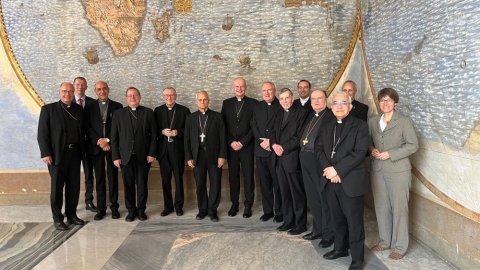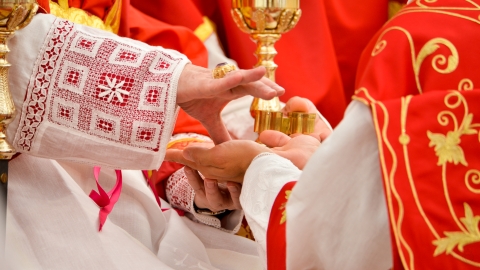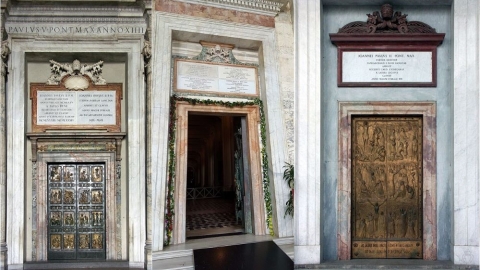Understanding Islam: The Sunnah and the Hadith

2000 years ago, Christianity made its humble entry into the world, and earned for its founder and apostles a violent death. For centuries, Christian blood would continue to flow that the earth might bear fruit. “The blood of the martyrs is the seed of Christians,” as Tertullian put it so well (Apology 50,13).
This article presents Muslim law by exploring its sources. The first part presented the Koran. We shall now consider Muslim tradition.
Tradition or the Sunnah
The second doctrinal and disciplinary source of Islam is the Prophet’s Sunnah, the “habitual practice or rule of behavior”, hence the term Sunnism that designates the major branch of contemporary Islam (85%), as opposed to Shiism (10%). The Koran calls Mohammed the “most excellent model”; he is supposed to have decreed positive religious and moral rules through his example, words and even silence. There are thus three types of sunnah: verbal, active, and tacit. To show the importance of tradition, one need only quote the aphorism “The Sunnah can do without the Koran, but the Koran cannot do without the Sunnah.” All Muslims agree that the Sunnah completes and explains the Koran. There are many laws that are given by the Sunnah but are not to be found in the Koran, stoning adulteresses for example.
The Formation of the Sunnah
After Mohammed’s death, the obscurity of the Koran soon proved insufficient for organizing the Muslim community (umma). They therefore turned to examples of the founder reported by witnesses who were considered trustworthy: the Companions of the Prophet (Sahabi). These were all those who spent time with the Prophet and passed down this tradition. This supposes that, fully conscious of their mission, they spent their time studying this “goodly model”, then diligently writing down or attentively memorizing the slightest details in order to transmit them to posterity. The term Companions also includes their descendants and successors who received these traditions from the lips of the first. Together, they form the class of the salafi, Fathers or ancestors, to which the Salafists claim to belong.
Preservation and Transmission
According to Muslim tradition, many sahabi collected all the teachings transmitted during the first century of the Hegira.[1] A special discipline, the hadith (literally, “novelty”), that would experience a prodigious development, would be born to organize this material.
Each hadith is composed of two parts, the isnad and the matn. The latter is the essential, the text of the hadith that must be scrupulously reproduced. The isnad gives the chain of authorities and guardians by which the hadith was passed down to the last transmitter.
This discipline would indeed have a very strong authority if all the hadiths came from Mohammed and his Companions, but this is absolutely not the case. At the time of the caliphates especially, the hadith served to create a tradition to suit various needs; they sought to justify a practice of the Sunnah, or to create a sunnah that did not yet exist, or to fix a trend of thought in favor of a new sunna. Primitive Islam’s political parties (caliphates) and religious parties (ulamas) used the hadith to their advantage with an unbridled production. They were later imitated by the dissident sects. Each party, sect or school of thought tended to possess the traditions most favorable to its claims or doctrines. The hadith even served the purposes of personal resentment: popular discontent even invented some against the police and tax collectors! The production became exponential.
Statistics of the Sunnah
The most ancient collections of hadiths were elaborated at the time of the Umayyad caliphs (660-749); the most important date back to the 9th century, when they began to classify the material to be used in the collections of hadiths. One of the most famous authors, Bukhari (who died in 870), collected 300,000… He declared 200,000 completely apocryphal and only kept 8,000.
Today there are over one-and-a-half million hadiths.[2] This precocious prolixity is so outrageous that Muslims scholars have long sought to evaluate the hadiths’ worth; this led to the development of an immense collection of works intent on verifying the solidity of the isnad. They led to a classification of the persons named in the chain: worthy of trust, exact, true, no objections, doubtful or weak. But the content is never questioned: the value of the tradition, the matn, cannot be questioned.
Critical Judgment
Let us now consider the information provided by the hadith. For the believer’s instruction, it relates how Mohammed accomplished his prayers and ablutions, how he ate, fasted, dressed, behaved in his home; one learns about his favorite dishes, the contents of his wardrobe, his apartments, his weapons, his horses, his camels and their names, their genealogy, their qualities… The Master is supposed to provide the answer to all future dogmatic, disciplinary and political difficulties. It gives a list naming all the cities and countries that will be conquered by Muslim arms. It condemns future heretics. It thus determines the Sunnah and completes the cursory prescriptions of the Koran.
Despite their implausibility, most Muslim writers refuse to dismiss these hadiths, no matter how contradictory or clearly apocryphal they may be. Those who admit that certain hadiths were invented simply point to the weaknesses in their isnad and the little worth of the persons named in the chain. The famous Islamologist, Louis Massignon, wrote that if all the hadiths with weak isnads were eliminated, “believers would be left with nothing more than a few prescriptions on hygiene and politeness.”[3] This remark leaves little material on which to base the life of Mohammed.
The Sirah
Towards the end of the 8th century, Muslim authors began to compose the Sira, or Life of Mohammed; there are many different versions of it. Almost all are taken from the hadith, for the Koran offers very few elements on the Prophet’s life. The historical value of these writings is the same as that of the source. Most of the details traditionally given in the Sira and complacently repeated in the Western world, are excessively doubtful. That is why it is impossible to write a biography on Mohammed. Fr. Lammens demonstrated that these texts add nothing to the Koran itself,[4] not a single fact, not a single precise detail, simply a prodigious development of the imagination to add color to what the Book says on Mohammed. For example, they offer names, descriptions, picturesque details, but not a single historical detail. The Sira is nothing more than a story from the Arabian Nights.
A Few Examples
The preexistence of Mohammed’s soul is one of tradition’s favorite dogmas; it is accepted by the Sira, but its origin is Platonic and Gnostic. The hadiths took this idea from misinterpreted texts in which Allah says to the faithful: “We have sent you a light.”[5] This theme was developed and applied to the person of the Prophet. His body gave off rays of light, making it visible in the midst of the thickest shadows. One night, this light allowed Aisha (one of the Prophet’s wives) to find a lost pin. Mohammed’s person “produced no shadow; his brilliance made the sun and torches look pale.” An intense source of light, he could see behind his back; he could see by night as by day. Better yet, he had a physical eye in the middle of his back or between his shoulders, no one is sure exactly where, and his clothes did not veil its “penetration”. This example shows the fertility, logic and methods of this tradition, persisting on a misinterpreted term.
Mohammed was given the name of Qotam at birth, but as the book of Allah called him Ahmad, or Mohammed, tradition did not wish to know any other. Traces of the first name can, however, be found by searching thoroughly in the hadiths.
How old was Mohammed when he died? He probably did not even know, like the Bedouins in our day. But tradition improvised a chronology in the Sira. The numbers vary between 60 and 65, based on a misinterpreted verse of the Koran. Some of the explanations are singularly imaginative. Here is one: “Each prophet reaches half the age of his predecessor; ‘Isa (the Arabian name for Jesus) lived for 125 years…” Conclusion: Mohammed lived for 62 and a half years.
The Arabs are very proud of their paternity. Mohammed went by the name (konia) of Abu’l Quasim, father of Quasim, his son. According to tradition, he forbade his followers to take this konia and add it to the name Mohammed. This assertion is contradicted by history: among the Prophet’s contemporaries and in the following generation, we know of several Abu’l Quasims whose name was Mohammed. Why this insinuated interdiction?
The story of Mohammed’s youth was suggested to the Sira by surah 93, in which Allah says: “We found you poor, an orphan, with no family.” These words gave the outline for a veritable Evangelium infantiae Muhameti.[6] It is impossible to verify the exactitude of this novel based on inconsistent elements and in which he suffers all the vicissitudes of Arabian orphans. The imagination of those writing the tradition made up for the missing information.
The Prophet’s male descendants are one of tradition’s favorite subject. It would seem that he had only one son. Brothers, therefore, had to be invented for Quasim; they doubled their numbers, took for real and distinct names the adjectives Tahir (pure) and Taiyb (good) attributed to Mohammed’s sons by popular piety, imagined several sets of twins for him. These artifices led to a total of twelve children, eight of whom were boys. In reading the Koran, it is impossible not to by struck be Mohammed’s suffering at his paternal disgrace, his protests against the name abtar (having no male descendants). Hence the long series of anecdotes in which the Prophet, even while praying, is seen playing with his grandchildren.
“Obey the apostle when he calls,” says the Koran. This text gave birth to a whole series of hadiths. It is seen as an obligation to interrupt anything, even prayer, to come running at a sign from Mohammed. The obligation was taken even further. A woman desired by him cannot refuse his hand. If she is married, her husband has to put her away. The Apostle must marry her whether she like it or not, against the will of the woman and her family. Did Allah not say, “The believers must prefer the Prophet to themselves”?[7]
One can therefore declare that Muslim tradition is not very reliable and that it is impossible to reconstruct the life of Mohammed based on this source alone. The same can be said of the Koran itself. External sources are necessary to reconstruct the history of Islam.
Conclusion
Islamic tradition (hadith) has nothing to do with Catholic Tradition, given by God, and a true source of Revelation. The hadith is a human source, a fruit of imagination, passion, power struggles, and attempts to justify that lead to a vast fraud, regardless of the intentions of those who elaborated it. Many more or less sincere Muslims are strongly attached to it, and thus prisoners of a very elaborate system of self-justification.
[1] The supposed date of Mohammed’s migration to Medina in the year 622, that the Muslims consider as year 0.
[2] Ayatollah Khomeini also brought a certain number of hadiths when he came to Iran…
[3] Louis Massignon, Essai sur les origines du lexique technique de la mystique musulmane, Ed Geuthner, Paris, 1922, p. 103.
[4] Henri Lammens, Qui était Mahomet ?, Ed. du Trident, 2014.
[5] The word light here is a synonym of the Koran.
[6] Gospel of the Childhood of Mohammed, in comparison with apocryphal gospels on the childhood of Christ.
[7] Koran, XXXIII, 6.36.
Sources: FSSPX.News – 3/22/2019 —





